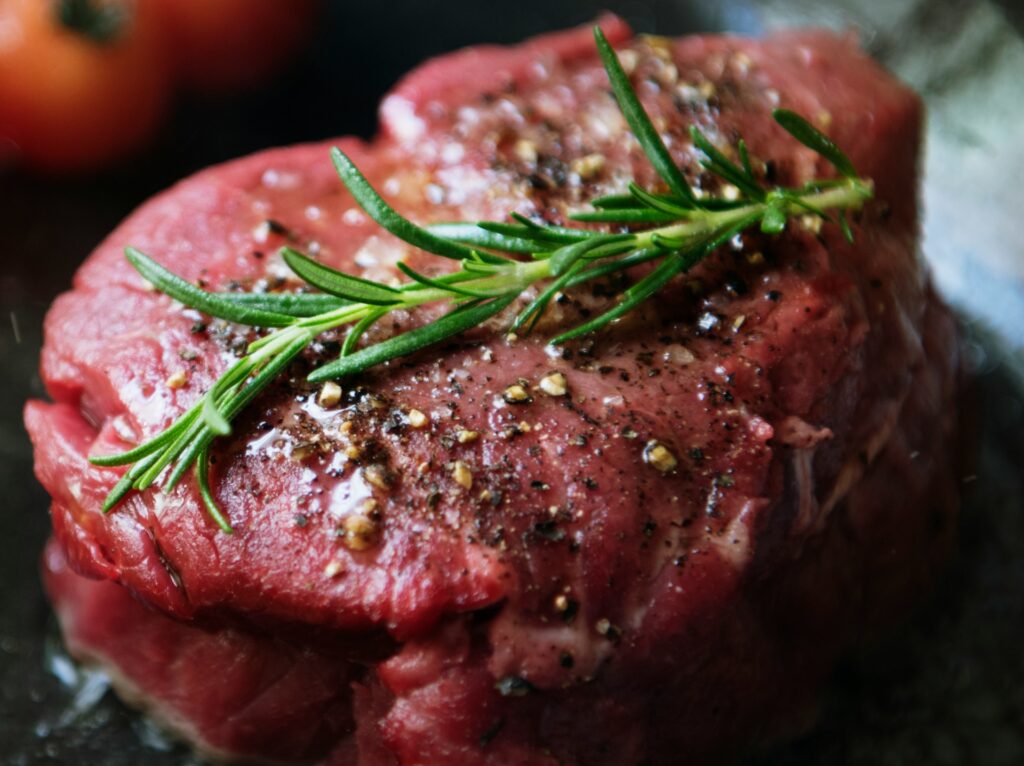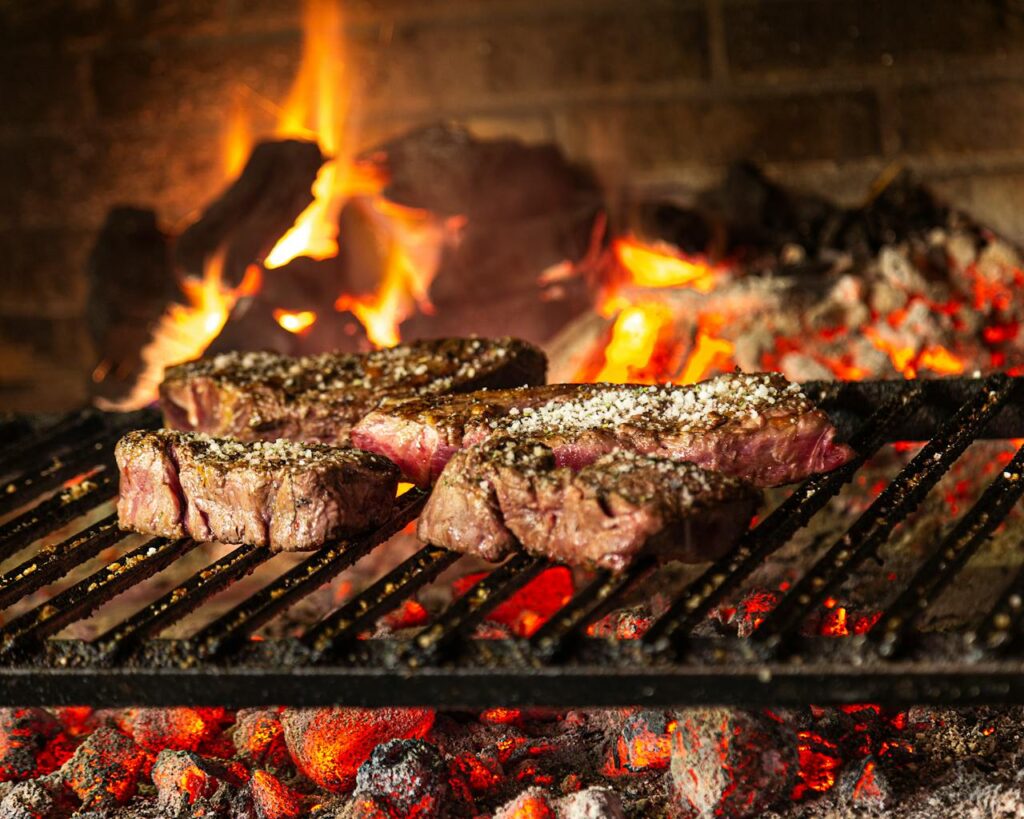We all love a properly blushing, nicely barked steak. Well, not all of us, of course; veggies and vegans look away now, and all that…
But have you ever stepped up to the meat counter at your local butchers and been overwhelmed by the paradox of choice? It’s only natural, but selecting the right cut is essential for a satisfying experience that matches a steakhouse, but at home.
Indeed, the difference in taste and texture between the various cuts is staggeringly vast. If you’re keen to choose the appropriate cut for the particular dinner you have in mind, then as much work is done in the butchers as it is at the stove.
Things To Look Out For At The Steak Counter
Selecting the perfect steak is an art that begins at the butcher’s counter. Here are some detailed tips to ensure you choose the best cut for a truly exceptional dining experience:
Colour & Freshness
A high-quality steak should have a vibrant, cherry-red colour, indicating freshness and proper handling. Avoid steaks with a pale or brownish tint, as these may have been improperly stored at the wrong temperature, or are simply past their prime. The colour should be consistent throughout the meat, with no greyish patches.


Thickness
The thickness of your steak is crucial for achieving the desired doneness without overcooking. A steak that is at least one inch thick is ideal for most cooking methods, providing a good balance between a well-seared exterior and a juicy interior. Thicker cuts allow for more control over the cooking process, making it easier to achieve the perfect medium-rare finish.
Marbling
Marbling refers to the white streaks of intramuscular fat within the meat. This fat melts during cooking, infusing the steak with flavour and keeping it moist. Look for steaks with even marbling throughout, as this is a sign of a well-fed animal and a high-quality cut. Cuts like ribeye and Wagyu are known for their excellent marbling, which contributes to their rich, buttery flavour.
Smell
Fresh steak should have a clean, slightly metallic smell. If the meat has a sour or off-putting odour, it is likely spoiled and should be avoided. Trust your senses; if something doesn’t smell right, it’s best to choose another cut.

Texture
The texture of the steak can also indicate its quality. The meat should be firm to the touch but not overly hard. A slight give when pressed is a good sign, indicating that the meat is fresh and has been properly aged. Avoid steaks that feel mushy or excessively soft, as these may be of lower quality or improperly handled.
Fat Cap
Some cuts, like ribeye and sirloin, come with a layer of fat on the edge known as the fat cap. This fat renders during cooking, adding flavour and moisture to the steak. Look for a thick, even fat cap, as this will enhance the overall taste and juiciness of the meat.
Read: Where to eat the best steak in London
Bone-In vs. Boneless
Bone-in steaks, such as T-bone or ribeye, tend to have more flavour due to the marrow and connective tissues that break down during cooking. However, boneless cuts are easier to handle and cook more evenly. Choose based on your preference and cooking method. By paying attention to these details, you can ensure that you select the best possible steak for your meal.

Choosing The Right Cut
Ribeye Steak (Scotch Fillet)
Ideal for: Fat distribution and flavour
Ribeye steak is renowned for its rich flavour and tender texture, making it a favourite among steak enthusiasts. This cut comes from the rib section of the cow, which is known for its excellent marbling. The intramuscular fat melts during cooking, infusing the meat with a buttery, juicy flavour. Ribeye is perfect for grilling or pan-searing, and its high-fat content makes it forgiving for novice cooks.

Cooking Tips:
- Grilling: Cook on high heat to sear the outside, then move to indirect heat to finish cooking. This method ensures a crispy exterior and a juicy interior.
- Pan-Searing: Use a cast-iron skillet for an even sear. Baste with butter, garlic, and herbs for added flavour.
- Resting: Let the steak rest for at least 5 minutes after cooking to allow the juices to redistribute, ensuring every bite is succulent.
Wagyu Beef
Ideal for: The most luxurious and tender cut
Wagyu beef is the epitome of luxury in the steak world. Known for its extraordinary marbling, Wagyu offers a melt-in-the-mouth experience that is hard to match. The cattle are raised under strict conditions to ensure the highest quality, resulting in beef that is incredibly tender and flavourful. Wagyu is best enjoyed in smaller portions due to its rich taste.

Cooking Tips:
- Low and Slow: Cooking wagyu steak is comparatively easy to get right, as the fat protects the meat from drying out. At first, cook at a lower temperature to render the fat slowly and evenly, preserving the delicate texture.
- Minimal Seasoning: The natural flavour is so rich that minimal seasoning is needed—just salt and pepper.
- Slicing: Cut thin slices against the grain to enhance tenderness and make the most of its luxurious texture.
Sirloin Steak
Ideal for: Versatility and rich beefy flavour
Sirloin steak is a versatile cut that offers a robust beefy flavour. It is cut from the section between the loin and the round, combining tenderness with a slight chew. Sirloin is suitable for various cooking methods, but especially grilling and stir-frying. However, its lower fat content means it can dry out if overcooked, so careful attention is needed.

Cooking Tips:
- Marinating: Use a marinade to add moisture and flavour. A simple mix of olive oil, garlic, and herbs works wonders.
- Quick Cooking: Cook quickly over high heat to avoid drying out. Aim for medium-rare to medium doneness.
- Resting: Allow the steak to rest for a few minutes before slicing to retain juices and enhance flavour.
Read: 8 IDEAL steps to the perfect steak
Fillet Steak (Tenderloin)
Ideal for: The most tender cut
The fillet or tenderloin steak is prized for its unparalleled tenderness. This cut comes from the long, slender muscle along the cow’s spine, which does very little work, resulting in a delicate texture. Fillet steak is a premium cut, often reserved for special occasions. Its mild flavour pairs well with delicate sauces.

Cooking Tips:
- Searing: Sear quickly on high heat to form a crust, then finish in the oven to ensure even cooking.
- Butter Basting: Baste with butter, garlic, and herbs for added flavour and moisture.
- Precision Cooking: Use a meat thermometer to avoid overcooking. Aim for medium-rare to maintain its tender texture.
T-Bone Steak
Ideal for: Combination of tenderness and juiciness
T-bone steak offers the best of both worlds, combining the tenderness of the fillet with the rich flavour of the strip steak. This cut includes a T-shaped bone with meat on both sides, making it a substantial and impressive choice for grilling.
The dual nature of the T-bone provides a variety of textures and flavours in one steak. This one is particularly good on the barbecue, as the bone protects the meat from overcooking against the unpredictability of the open flame.

Cooking Tips:
- Two-Zone Cooking: Use a two-zone fire on the barbecue grill to cook the strip and tenderloin sides evenly. Start with high heat to sear, then move to indirect heat to finish.
- Resting: Let the steak rest for at least 10 minutes to allow the juices to redistribute, ensuring a juicy bite.
- Slicing: Cut along the bone to separate the strip and tenderloin before serving, making it easier to enjoy both cuts.
Rump Steak
Ideal for: Robust flavour and an enjoyable chew
Another good one for the grill, rump steak is cut from the hindquarters of the cow and is known for its robust flavour. It is a leaner cut compared to ribeye or sirloin but can be very tender if cooked properly. Rump steak is versatile and its strong beefy flavour makes it a favourite for those who enjoy a more pronounced taste.

Cooking Tips:
- Tenderising: Use a meat mallet to tenderise the steak before cooking.
- Marinating: Marinate for several hours to enhance flavour and tenderness.
- Searing: Sear on high heat to lock in juices, then finish cooking at a lower temperature.
Flat Iron Steak
Ideal for: Budget-friendly tenderness and a la minute cooking
Flat iron steak, also known as butler’s steak or oyster blade steak, is cut from the shoulder of the cow. It is known for its tenderness and rich flavour, making it a popular choice for grilling or pan-frying. Despite being a relatively inexpensive cut, it offers a great balance of flavour and tenderness. It’s an excellent choice for those seeking a tender steak without breaking the bank.
Cooking Tips:
- Grilling: Grill over medium-high heat for a perfect sear.
- Slicing: Slice against the grain to maximise tenderness.
- Seasoning: Use a simple seasoning of salt, pepper, and olive oil to let the natural flavour shine.
Read: 14 of London’s best New York-inspired restaurant
Internal Temperatures For Steak
To achieve the perfect doneness, use a meat thermometer to check the internal temperature of your steak. Here are the recommended temperatures for different levels of doneness:
- Rare: 50-52°C (120-125°F) – Cool red centre
- Medium Rare: 57-60°C (135-140°F) – Warm red centre
- Medium: 63-68°C (145-155°F) – Warm pink centre
- Medium Well: 70-73°C (160-165°F) – Slightly pink centre
- Well Done: 75°C (170°F) and above – Little or no pink
When preparing a delicious dinner, whether it’s a date night, special occasion, or just a Tuesday and you feel like treating yourself, steak reigns supreme. The trick is picking the perfect steak cut for your dish, with as much effort needed at the butchers as it is in the kitchen. Now, please don’t overcook yours!





